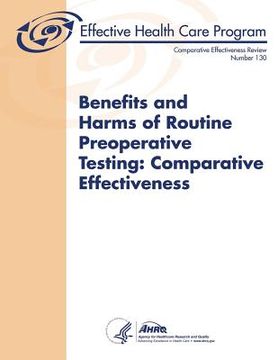Benefits and Harms of Routine Preoperative Testing: Comparative Effectiveness: Comparative Effectiveness Review Number 130 (en Inglés)
Reseña del libro "Benefits and Harms of Routine Preoperative Testing: Comparative Effectiveness: Comparative Effectiveness Review Number 130 (en Inglés)"
Traditionally, preoperative testing has been part of the preoperative care process to inform patient selection by determining fitness for anesthesia and identifying patients at high risk for perioperative complications. The American Society of Anesthesiologists defines routine preoperative tests as those done in the absence of any specific clinical indication or purpose; they typically include a panel of blood tests, urine tests, chest radiography, and electrocardiogram. These tests are performed to find latent abnormalities, such as anemia or silent heart disease, that could impact how, when, or whether the planned surgical procedure and concomitant anesthesia are performed. Many hospitals have instituted protocols to perform a series of laboratory tests prior to any operative procedure under the assumption that this information will enhance safety for surgical patients and reduce liability for adverse events. During the past three decades, routine preoperative testing has been challenged by several academic publications with concerns about the sizable cost of testing, overtesting, the consequences of false-positive tests, and the unknown benefit to patients. In addition to increasing the cost of surgical care, nonselective preoperative testing may result in false-positive or borderline results, which require further investigation. Additional investigation may cause unnecessary psychological and economic burdens, postponement of surgery, and even morbidity and mortality. As all routine testing does, preoperative testing will find some abnormal test results that will lead to new diagnoses but it is unclear whether the benefits accrued from responses to true-positive tests outweigh the harms of false-positive preoperative tests and, if there is a net benefit, how this benefit compares with the resource utilization required for testing. There is no common terminology among anesthesiologists and surgeons regarding the alternative preoperative testing strategies. For this review, we define the three main alternatives as follows: (1) routine preoperative testing, in which the tests of interest are conducted in all patients undergoing a given procedure, regardless of medical history or other patient features; (2) per-protocol preoperative testing, in which the tests of interest are conducted in a subset of patients undergoing a given procedure, such as ECG only in patients aged less than or equal to 50 years or hemoglobin only in premenopausal women; (3) ad hoc, or elective, testing, in which preoperative testing is done at the discretion of the clinician doing a preoperative evaluation, based on patient history or physical examination findings. No tests are done routinely or based on any protocol. We address the following Key Questions: KQ 1: How do routine or per-protocol preoperative testing strategies compare to no testing or alternative testing strategies with respect to outcomes-including perioperative clinical outcomes, quality of life or satisfaction, periprocedural patient management decisions, and resource utilization-among patients undergoing elective surgical procedures? How do outcomes vary by a. The risk of the surgical procedure, the type of anesthesia planned, the indication for surgery, comorbidities, or other patient characteristics? b. The structure of testing (e.g., routine for everyone vs. per protocol, whether testing is conducted in a specialized preoperative clinic) or who orders the tests (e.g., surgeon vs. anesthesiologist vs. primary care physician)? c. The length of time prior to the procedure that the tests are conducted? KQ 2: What are the harms of routine or per-protocol preoperative testing strategies compared to no testing or to alternative testing strategies? How do outcomes vary by: a. The risk of the surgical procedure, the type of anesthesia planned, the indication for surgery, comorbidities, or other patient characteristics? b. The structure of testing or who orders the tests?

